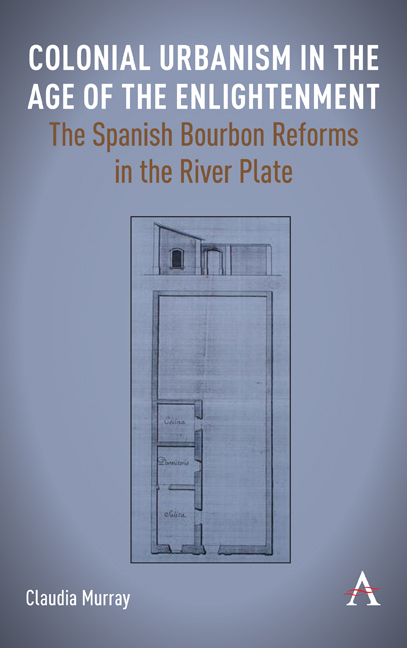Book contents
- Frontmatter
- Contents
- List of Figures and Tables
- Acknowledgements
- Introduction
- 1 The Spanish Empire Before the Bourbon Reforms
- 2 The River Plate Before 1776 and the Bourbon Reforms
- 3 Urban Expansion
- 4 The Image of Power
- 5 Ceremonies of Power
- 6 Disciplining Porteños’ Private Architecture
- 7 The British Assault on the River Plate
- Appendix 1
- Bibliography
- Index
4 - The Image of Power
Published online by Cambridge University Press: 28 February 2024
- Frontmatter
- Contents
- List of Figures and Tables
- Acknowledgements
- Introduction
- 1 The Spanish Empire Before the Bourbon Reforms
- 2 The River Plate Before 1776 and the Bourbon Reforms
- 3 Urban Expansion
- 4 The Image of Power
- 5 Ceremonies of Power
- 6 Disciplining Porteños’ Private Architecture
- 7 The British Assault on the River Plate
- Appendix 1
- Bibliography
- Index
Summary
Enlightened Urbanisation
During the eighteenth century, many peninsular and colonial cities of the Spanish empire focused on improvements and modernisation of public services on offer, such as waste collection, street paving and lighting, with the aim of bettering urban health standards. While these measures tried to improve urban conditions and benefit its citizens, local authorities simultaneously used them to enhance the overall image of the city and with it, the image of the empire and the monarchy. Indeed, it was during this century when European governments realised that travellers’ accounts and maps were becoming more widely available thanks to the widespread distribution of books that disseminated urban images to a global public. Urban images were therefore an opportunity for European governments to impress their rivals with tales and images describing architecture, monuments, or local festivities. This meant that urban developments carried out in Buenos Aires had to be as aspirational as those in other Spanish colonial centres were. Furthermore, as this city was now the capital of one of the four viceroyalties of the empire, it had to set even higher standards and spread stylistic trends as well as public health innovations across the River Plate area that was under its control. This was a tall order for a small town at the periphery of the colonies, with a skyline dominated by the domes of religious buildings. The task now was to shake-off this catholic and rural image and become a modern capital for an enlightened society.
Thinkers of the Enlightenment argued that cities were the way to progress. An ‘urban man’ was a civilised man and the elimination of ignorance was only possible through the secularisation of the city. Achieving this in the eighteenth century meant the expansion of public places where society could mingle and enjoy leisure activities, and not just spaces for religious and/or political gatherings. The century saw a rise in the development of promenades, parks and even entire towns were redesigned around the concept of health as a social activity, with spa towns spreading across Europe, with visitors arriving in the summer months to enjoy the restorative power of thermal baths or to drink from famous wells providing mineral waters.
- Type
- Chapter
- Information
- Colonial Urbanism in the Age of the EnlightenmentThe Spanish Bourbon Reforms in the River Plate, pp. 79 - 122Publisher: Anthem PressPrint publication year: 2023



